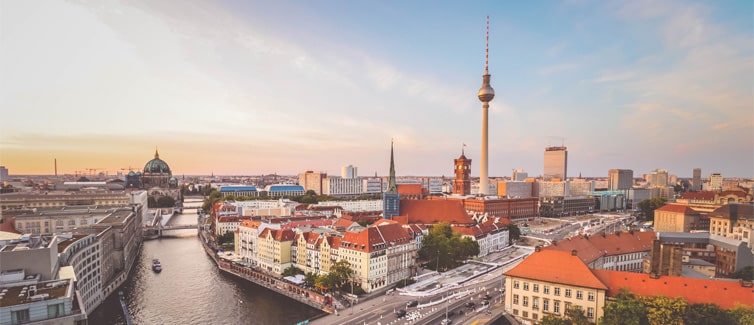

Berlin is the capital city of Germany and the largest city in the European Union with a population of almost 3.7 million residents. Located in northeast Germany along the River Spree, Berlin has an important history as a global centre for politics, culture, media and scientific research. The city also functions as a major hub for large-scale businesses and world-leading employers in a wide range of industries such as IT, pharmaceuticals, biotechnology and construction.
With nearly a million Berlin residents being foreign-born or first-generation immigrants, the city is welcoming and friendly towards all cultures and nationalities. Berlin is also well-known as an educational hub with its multiple world-class institutes and universities, each with their own history of high-quality academics, research and innovation. The large numbers of youthful residents also make Berlin a vibrant city with many entertainment venues and opportunities for recreation.
READ MORE: Why Study in Berlin?
Founded in 1948 with extensive international support in post-war Germany, the Free University of Berlin is committed to offering a non-political and research-focused university experience to international students.
With a total enrolment of 27,000 students of which 25% is international admits, the Free University of Berlin offers over 150 degree programmes and has overseas institutes in seven locations including New Delhi, Moscow, New York and Cairo. One of eleven designated ‘German Universities of Excellence’, the university is primarily located in the Dahlem neighbourhood in southwest Berlin.
Having been a prominent site for student-led protests in the 1960s and 1970s, it shifted focus in the 1990s to become a primarily research-focused university. Today, the university operates multiple world-class research institutes such as the Max Planck Institute for Human Development and the Max Planck Institute for Molecular Genetics.
Founded in 1810, the Humboldt University of Berlin has established itself as a top-ranked university, especially in regard to Arts & Humanities courses. The university is home to over 32,000 enrolled students, of which about 6,000 are international students. Humboldt University was one of the world’s first institutes to put equal focus on teaching as well as hands-on research work for its students, a mindset that is followed by most modern universities today.
With a list of 29 Nobel Prize-winning alumni, as well as Albert Einstein having taught at the university, it has world-class credentials when it comes to academic research. Recognised by the national government as a “German University of Excellence” for its nation-leading quality of research, Humboldt operates multiple Integrative Research Institutes (IRI) such as the Integrative Research Institute for the Sciences and the Integrative Research Institute for Law & Society.
The Technical University of Berlin was founded in 1879 and is currently home to over 6,000 international students among 22,000 enrolled students. An urban university with a reputation for world-leading scientific innovation, the university also operates a satellite campus in Egypt for international students pursuing specific research programmes.
TU Berlin is a member of the TU9, a society of the leading German technology institutes. The university’s primary Berlin campus is located in the neighbourhood of Charlottenburg-Wilmersdorf.
The university places great importance on encouraging students to innovate through their research, and operates two innovation centres designated by the European Institute of Innovation and Technology. The university’s location in the heart of Berlin allows international students to easily locate internship and employment opportunities with some of the world’s biggest firms in multiple industries.
The Charité – Universitätsmedizin Berlin is one of the world’s leading medical schools and operates one of the continent’s largest university hospitals. The university is home to 8,000 enrolled students of which about 1,600 are international students.
The university is located on four campuses across Berlin – Campus Benjamin Franklin, Campus Charité Mitte, Campus Virchow-Klinikum and Campus Berlin Buch.
With the university hospital itself employing 3,700 doctors every year, many international students continue with a job at the university post-graduation. If not, then the Charité – Universitätsmedizin Berlin’s extensive connections with medical institutes all over the globe make it straightforward for you to land an ideal position in a well-respected medical organisation.
Located just under two hours south of Berlin in the city of Dresden, the Technische Universität Dresden was originally founded as the Royal Saxon Technical School in 1828.
TU Dresden offers over 125 degree programmes to its 5,500 international students, and has a total enrollment of over 30,000 students. The university is uniquely well-regarded as a research university due to being a member of both the 11 “German Universities of Excellence” as well as the TU9.
Although Dresden is a small city, its scenic beauty and proximity to Berlin means international students will never find themselves bored or lacking activities outside the classroom. Moreover, you will have a sizable international student community to support you during your time at TU Dresden.
Below are the top-ranked Berlin universities for international students, with their ranks in two of the world’s most well-respected international university rankings, the QS 2025 University World rankings and the Times Higher Education 2025 Rankings.
For more information about rankings systems and methodologies see our University rankings explained guide.
| University | QS World Ranking 2025 | Times Higher Education Ranking 2025 |
| Free University of Berlin | 97 | =104 |
| Humboldt University of Berlin | =126 | =84 |
| Technical University of Berlin | 147 | 140 |
| Charité – Universitätsmedizin Berlin | – | =93 |
| Technische Universität Dresden (TUD) | 234 | =160 |
It must be noted that because of QS World Rankings’ policy of only featuring multi-faculty universities, Charité – Universitätsmedizin Berlin does not feature on the 2023 QS Global Rankings.
International students will be delighted to know that German public universities charge nearly zero tuition fees! In 2014, Germany abolished tuition fees for domestic as well as international undergraduate students at all public universities.
International undergraduates at public universities in Germany can effectively study for free, and must pay only a minor semester fee amounting to about 300-400 US Dollars per annum. The option of studying at a world-class university for an extremely affordable semester fee makes top-ranked German universities excellent value for money for international students.
According to the Berlin School of Business and Innovation, international students should budget between 800 and 900 US Dollars every month for living costs. This figure includes 400-450 US Dollars for shared accommodation, 200-220 US Dollars for food expenses, 50-60 US Dollars for public transport, 80-100 US Dollars for entertainment and another 80-100 US Dollars for miscellaneous expenses.
Berlin has interesting attractions in store for every international student. Students of politics will be fascinated by a trip to the Reichstag, or German parliament building, whereas art lovers will have an excellent day exploring Museum Island, a small river island home to five museums. The world-famous palaces on the outskirts of the city are also worth a short day-trip from your university.
Berlin is also well-known for its vibrant nightlife and entertainment scene, as well as the many high-quality restaurants and cuisines available in every neighbourhood. Berlin ranked number 13 in the quality of living city ranking in 2019 by Mercer, proving the city’s suitability for international students with its world-class urban infrastructure, transport options and public safety levels. Below are a few of the attractions you can enjoy in Berlin during your time away from the classroom:
Aside from the above attractions, Berlin offers multiple outdoor spaces where you can enjoy a relaxing day in the sun and engage in physical activity. You can also conveniently travel to Berlin straight from your home country via flights to the Berlin Brandenburg Airport.
The excellent connectivity of public transport all over Germany means that you can easily explore the country and its regions, such as Bavaria, during weekend breaks, as well as travel comfortably to nearby destinations including Amsterdam and Brussels. Of all the large-scale cities in Europe, Berlin is perhaps the most affordable yet also features the best standards of living and public safety. This combination of factors makes Berlin a favourite for international students looking to Europe as a study destination.
See all universities in Germany.
Study in GermanyJoin the StudyLink email list and never miss a chance to turn your study abroad dreams into reality!

Read our key advice article to help you make the best decision for your education and start your International study adventure.

In this article we look at how to approach choosing where in the world you would like to study.

Read StudyLink's suggestions on your first steps when deciding where to study abroad, with helpful tips to make your decision easier.

Find out more about English language tests, your options and what is required as an overseas student.

StudyLink.com take a detailed look into the costs of studying abroad and all the aspects that you should budget for when embarking on your studies.

We answer 10 common questions about applying for a student visa to help make your visa application quick and easy.

Find out more about international student visas for studying abroad, as well as how, where and when to apply for yours.

Find out more about funding and scholarships for international students, and what financial assistance might be available to you.

How to choose a course that fits you? Check our top tips on choosing which course is best for you to help you make an informed decision.
The latest articles from study abroad providers and StudyLink.com to hep you on your study abroad journey.